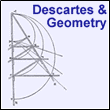forum
library
tutorial
contact

Equiangular or Logarithmic Spiral
from Curious and Interesting Geometryby David Wells
|
the film forum library tutorial contact |

|
Equiangular or Logarithmic Spiralfrom Curious and Interesting Geometryby David Wells |
Discovered by Descartes in 1638, it cuts any radius through the origin at the same angle. If that angle is called p, then the polar equation of the spiral is:
r = a exp(t cot p)
It was studied by Jakob Bernoulli, who was so impressed by its tendency to appear as transformations of itself that he left instructions that the curve be engraved on his tomb, together with the words Eadem mutata resurgo ('I shall arise the same though changed').
Its evolute is an equal equiangular spiral, and so is its inverse with respect to the origin. If a light source is place at the origin, then its caustics by reflection and by refraction are also identical equiangular spirals.
It is similar to itself, in the sense that if any part of the curve is blown up or reduced, it is identical to another portion of the same curve.
If the spiral is rolled along a straight line, then the path of the origin of the spiral, called its pole, is another straight line. The length of the curve from the pole (call it point O) to the point X (the "tangent" to the line), is equal to XT, where T is the starting point of the pole and TOX is a right angle.
(Figure not shown on this web site.)
The equiangluar spiral occurs again and again in nature. For example, the whorls of the nautilus shell are equiangular spirals. However, patterns such as those in sunflower heads are only approximately equiangular spirals; they are better described by Fermat spirals.
learn more on topics covered in the film
see the video
read the script
learn the songs
discussion forum
